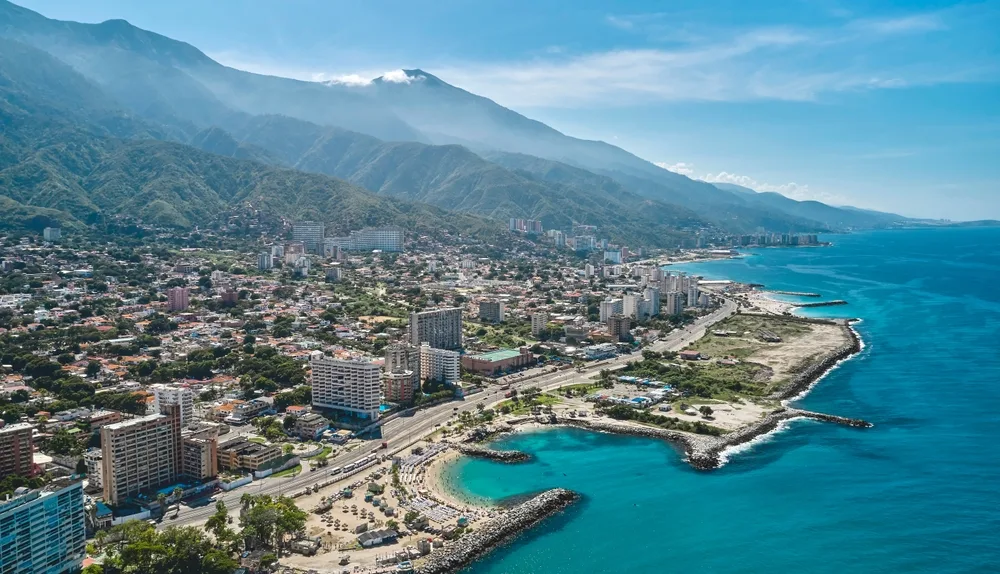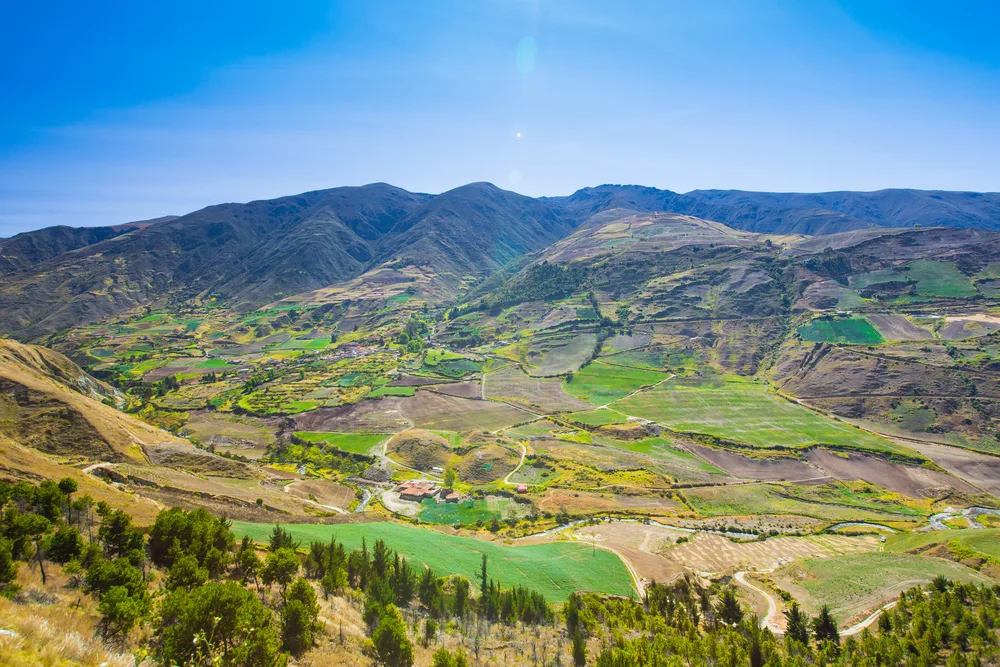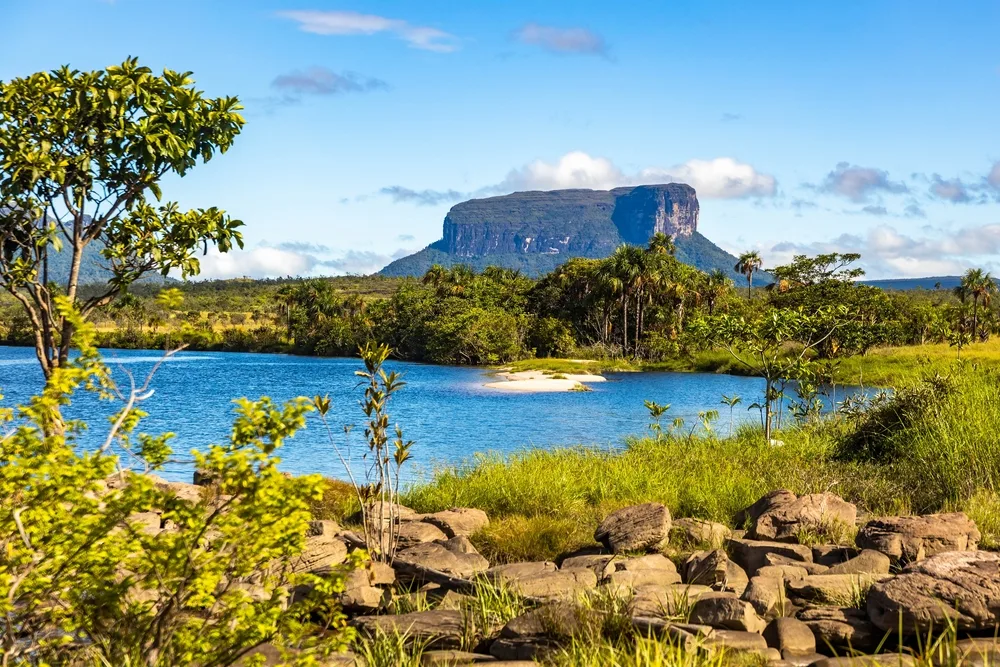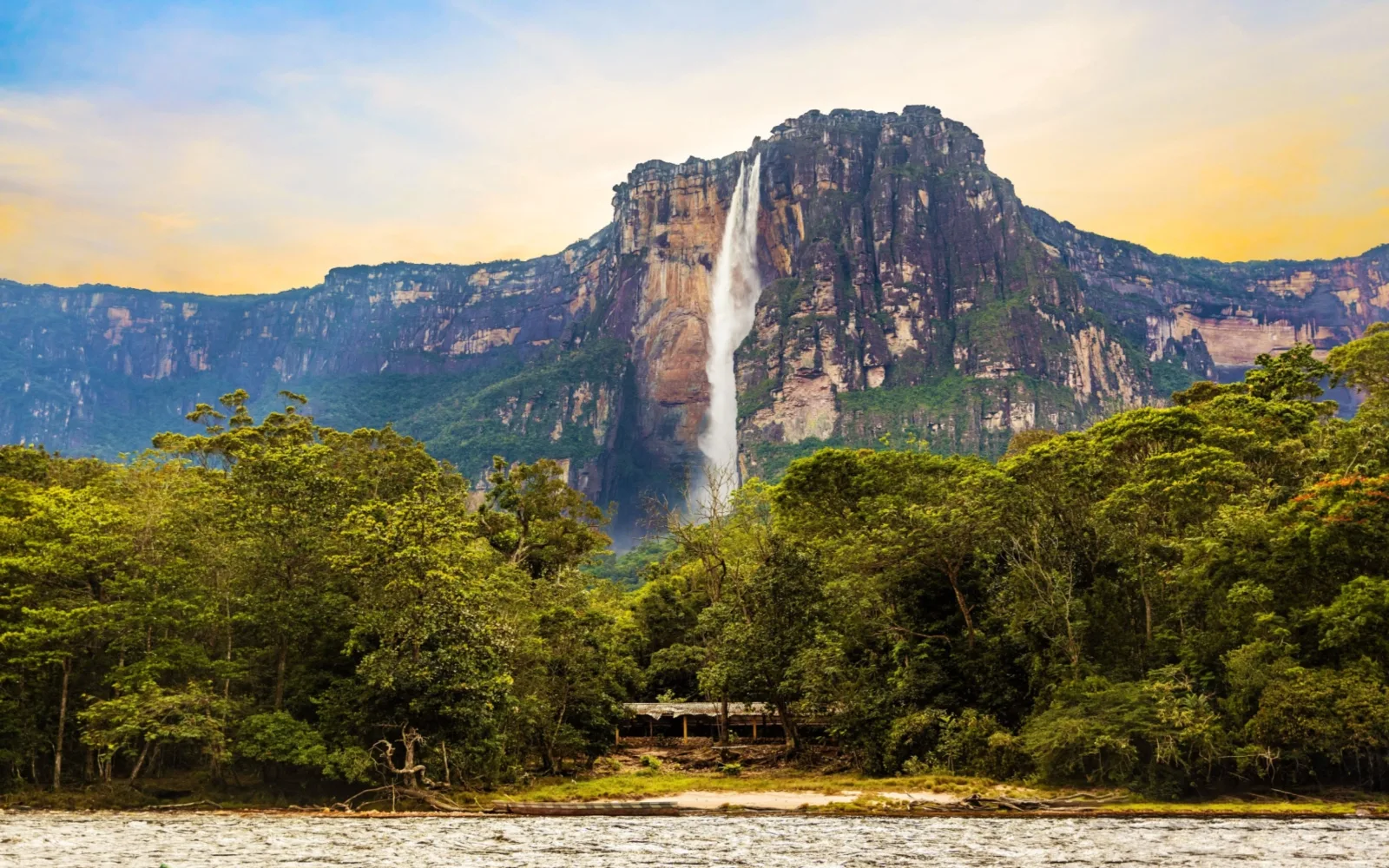What's the best time to visit Venezuela?
The best time to visit Venezuela is between December and April. This is the dry season with warm weather ranging from the mid-70s to the low 90s. The Caribbean beaches, parks like Sierra Nevada, and historic town from Caracas to Merida are excellent choices to visit during the dry season. December and February offer the best deals during the peak season, while April sees the smallest crowds.
Sky-high waterfalls and lush rainforests, luxurious beaches, colorful culture, spicy aromas, and rugged mountains class Venezuela as one of the coolest destinations in South America. From tropical Caribbean shores to rainforest wildlife, it’s a stunning place to visit.
Mighty rivers, like the Orinoco, filled with strange and rare wildlife eventually cascade into the world’s tallest, most powerful, and beautiful waterfalls here. Buzzing cities, from the capital, Caracas, to historic Maracaibo offer you a glimpse into the culture and vibrancy of Venezuela through food, art, and museums.
Whether you’re seeking a tropical beach getaway somewhere new and different, can’t wait to get lost in a storied city, or want to do some adventurous exploration, Venezuela can be the perfect destination. You just need to know the best time to visit Venezuela to make it happen.
The best time to go depends on what you’re looking for — idyllic dry weather, affordable prices, small crowds, or cultural and seasonal events to fill your itinerary. We’ve uncovered the best, cheapest, least busy, and worst months to go to Venezuela to help you plan the right travel dates.
Take a look at how Venezuela varies by the month and see average weather, costs, crowds, and activities for different parts of the year below. You’ll prepare yourself and be able to pinpoint the perfect time to visit!
Overall Best Time to Visit Venezuela

rjankovsky/Shutterstock
The overall best time to visit Venezuela is between December and April. This period can be crowded, but it offers the best, dry weather to explore and enjoy all of Venezuela’s landscapes and cities without interruptions from the rain.
The weather in Venezuela is tropical and warm year-round, which is great for beaches and outdoor adventures in the rainforest and mountains. But this part of the year sees the mildest weather with dry conditions, making it the best:
- December: 74-90°F; 3-15 rainy days
- January: 74-90°F; 1-12 rainy days
- February: 75-90°F; 1-13 rainy days
- March: 75-91°F; 2-16 rainy days
- April: 75-91°F; 6-20 rainy days
While parts of the best season can be busy (December and January are peak months), you’ll find steadily-shrinking crowds from February to April, which is one of the least busy months to visit Venezuela.
With dry, warm weather ranging from highs in the mid-70s to the low 90s, this is the prime time to explore Venezuela’s Caribbean coast and offshore islands.
Treat yourself to a tropical vacation by visiting the Los Roques archipelago or Isla de Margarita on the Caribbean coast. Isla de Margarita is known for its pearls, beautiful beaches, and wildlife-filled mangroves in Laguna de la Restinga National Park.
The Los Roques islands (300+) are a popular destination with around 60 inns (posadas) that give you quick access to the pristine beaches, coral reefs, and the stunning Los Roques National Park. Kayak through mangroves, dive colorful reefs, kitesurf, or go fishing.
Explore Caracas, the capital city, and its many historic sites. You can see the 17th-century Caracas Cathedral, the lovely Parque Central with its tall 738′ towers, and art museums and galleries like the Centro de Arte Los Galpones and the National Art Gallery.
You can also head to Canaima National Park to check out the 360′ Aponwao Falls during the dry season. These impressive falls flood endlessly over a horseshoe canyon amid the table mountains.
While other falls, like Angel Falls, are less spectacular this time of year, this mighty waterfall flows forcefully and casts a misty rainbow in front of it. You can always go to see Angel Falls during these months — it’s better to go during December or April.
Of course, choosing the overall best months to travel means you’ll end up spending more. But you can still find some months with better deals than others. Take a look at data from Google Hotels and Skyscanner to see how it costs:
- December: $123/night; flights from $1,022
- January: $138/night; flights from $1,534
- February: $126/night; flights from $1,085
- March: $160/night; flights from $1,474
- April: $157/night; flights from $979
December and February are the cheapest months to visit during the peak season period, so look for hotels and flights during either if you want to save on your trip. March is the most expensive month to visit and January isn’t far behind.
There are some interesting cultural festivals and events that take place during the peak season, so see if you can attend one or more of the following while you’re in the country:
- Christmas Celebrations (Dec) start the 16th through the 24th, or Noche Buena, with special masses said daily and a midnight mass called Misa de Gallo; cities also decorate for the season with lights and trees
- Fiesta de San Benito (late Dec) just after Christmas celebrates San Benito, the Moor, known as the black saint of Venezuela with costumes, dancing, and food carts
- Día de Los Inocentes (Dec 28) is Venezuela’s April Fool’s Day with pranks and fun games being pulled across the country with fake newscasts, newspaper stories, and water fights in the streets
- Feria Del Sol (Feb) or Festival of the Sun in historic Merida happens alongside Carnival with bull competitions, concerts, sporting events, and pageants at Plaza de Toros
- Carnival (Feb/Mar) brings 2 days of colorful fun to Venezuela ahead of Easter with water fights, parades, flamboyant costumes, music, and dancing, especially in coastal towns like El Callao and Carúpano
- Semana Santa (Mar/Apr) or Holy Week leads up to Easter with a blessing of palm leaves in Caracas on Palm Sunday, a city-wide procession to Plaza Caracas, and theatrical reenactments of Christ’s crucifixion along with an effigy burning of Judas
Overall, you won’t find a better, drier time to visit Venezuela than between December and April. Opt for April to avoid crowds or December/February if you want to save money on your trip.
Cheapest Time to Visit Venezuela

Aleh Mikalaichyk/Shutterstock
The cheapest time to visit Venezuela is during June-July and September-October. These months are warm to hot and all are part of the rainy season, seeing up to 25 days of rain per month in the wettest areas (like the Amazon Basin).
There’s no doubt that you can save money on your trip to Venezuela during these summer and fall months, but it comes at a cost: the weather. There’s a lot of rain this time of year, which can interfere with outdoor activities and sightseeing.
- June: 76-92°F; 8-25 rainy days
- July: 76-93°F; 6-24 rainy days
- September: 77-92°F; 11-20 rainy days
- October: 76-90°F; 12-20 rainy days
Crowds vary quite a bit during these affordable months. June is one of the least busy months to visit, while July sees moderate crowds. September and October are quite busy, but not as crowded as the peak months of December and January.
This time of year, it looks like there’s a lot of rainfall, but the higher end of the rainfall estimates are located in the Amazon Basin. Elsewhere, rainfall is on the lower end (around 8 days in June, 11 days in September, and so on).
The driest parts of Venezuela during the May-November rainy season are Valencia, Caracas, and Maracaibo. Merida sees moderate rain, while places in the Amazon Basin (like La Esmeralda) get inundated with heavy, near-daily rains.
This is actually the best time of year to visit Angel Falls — the rainy season fuels it up and ensures the falls are powerfully flowing for the most memorable experience.
In Canaima National Park, you can reach the falls by boat by traveling up to a fork in the Río Kerepacupai Merú, or opt for a fly-by to see the 3,212′ (979m) tall cascade from a bird’s eye view.
Walk under Sapo Falls in the same park — a truly powerful experience that will leave you drenched and feeling fully alive. Remove your shoes to walk the path behind the thundering falls.
A short guided boat trip across the Canaima Lagoon will bring you here. Bring a dry bag for your electronics and gear!
As far as pricing goes, this is a winner. You’ll find the lowest prices in October, but according to data from Google Hotels and Skyscanner, it’s really affordable to visit during any of these months:
- June: $116/night; flights from $537
- July: $117/night; flights from $584
- September: $114/night; flights from $551
- October: $114/night; flights from $547
You could pay as little as $1,345 for a 7-day trip to Venezuela in October with the potential price being just a few dollars higher in June and September. In July, that cost could be around $1,400. Talk about a cheap time to visit!
You’ll have some fun festivals and events to look forward to if you visit Venezuela during the cheapest time of year, including these:
- Dancing Devils of Corpus Christi (May/Jun) or Los Diablos Danzantes in San Francisco de Yare features men in devilish masks and costumes dancing through the square as people shake maracas to ward off evil on Holy Thursday
- Festival of San Juan (Jun) in Curiepe brings African and Venezuelan culture together with huge bonfires, drinking, dancing, and nighttime drumming to commemorate the death of Saint John
- Festival Virgen del Valle (Sept) in the Los Roques archipelago celebrates the Virgin of the Valley, the patroness of the islands, with turquoise-colored decorations, traditional music and dance, feasts, and more
- Festival de Virgen de Coromoto (Sept 11) honors the patron saint of Venezuela, the Virgin of Coromoto, with special masses held, street processions and parades, and giant communal feasts in cities across the nation
You’ll save big by planning your trip during the rainy season from June to July or September to October. Since there are some drier areas and destinations that are even better during the rainy season (like Angel Falls), it can be a great time to go.
Least Busy Time to Visit Venezuela

Photo Spirit/Shutterstock
The least busy time to visit Venezuela is during April, May, and June. These low season months encompass the end of the dry season (April) and the start of the rainy season (May and June).
The less-crowded months of April, May, and June can be tempting for a visit if you really want to avoid big crowds of tourists and take your pick from the best hotels, avoid waiting at restaurants and attractions, and enjoy near-empty hiking trails.
The weather this time of year starts off dry in April and gets wetter as the rainy season arrives in May and June. That means you’ll have a chance to get in before the rains and enjoy more outdoor activities.
- April: 75-91°F; 6-20 rainy days
- May: 76-91°F; 10-25 rainy days
- June: 76-92°F; 8-25 rainy days
Temperatures are higher during these months. It’s hotter in spots like Maracaibo and Valencia along and near the Caribbean coast. It’s cooler further inland, especially in the Amazon Basin and in the Andes Mountains.
Look for rare pink river dolphins in the Orinoco rainforest delta, where you can see caimans lounging riverside, manatees floating lazily in the water, and flamboyant birds flocking to the trees and diving into the water for fish.
On a river cruise through the Orinoco rainforest, the amazing biodiversity will blow your mind. Toucans, jaguars, howler monkeys, anacondas, and squawking macaws surround you with the sounds and sights of Venezuela’s wilderness.
Take your river cruise a step further and venture into a jungle village untouched by the modern world. Wooden homes on stilts and talented craftsmen from the Warao Indian tribe offer hammocks, baskets, and carved figurines for sale and welcome you into a glimpse of their natural world.
Head to Maracaibo in northwestern Venezuela (Zulia state) to admire the Old Town. You’ll see colonial architecture, colorful homes on Calle Carabobo, and the stunning Maracaibo Cathedral with its Cristo Negro (Black Christ) statue.
In Maracaibo, you can witness an awesome natural phenomena known as the Catatumbo Lightning over Lake Maracaibo.
Between April and November, near-constant thunderstorms over the lake generate electricity that creates thrilling displays and bolts of lightning over the lake. It’s a spectacular thing to see and you can grab some amazing photos.
The months from April-June see moderate prices on hotels and flights, so you won’t break the bank by choosing the least busy months. Here’s what we found in Google Hotels and Skyscanner data:
- April: $157/night; flights from $979
- May: $114/night; flights from $634
- June: $116/night; flights from $537
June is actually one of the cheapest months to visit Venezuela overall, so it’s a great choice to combine smaller crowds with lower prices. May is affordable, but April is a bit more expensive.
From Semana Santa celebrations and the Festival San Juan to the Dancing Devils of Corpus Christi, there are some really interesting cultural and religious events that take place during these months.
If you’re hoping for quiet beaches, come in April before the rains. If you want low prices and smaller crowds, May and June are your best bets during the least busy season in Venezuela.
Worst Time to Visit Venezuela

testing/Shutterstock
The worst time to visit Venezuela depends on your trip goals, but for most, it’s going to be March and July-August. March is the most expensive month to visit, while July and August are two of the wettest and hottest months of the year.
With busy March bringing crowds and warm, dry weather, it’s the more ideal month to visit among these 3. July and August see moderate crowds, but rainy weather and hotter temperatures.
- March: 75-91°F; 2-16 rainy days
- July: 76-93°F; 6-24 rainy days
- August: 77-93°F; 8-23 rainy days
The most popular beach destinations, like Isla de Margarita on the Caribbean Sea, see around 14 rainy days during July and August. That means a planned beach trip can be a washout with cloudy skies in between the powerful showers and thunderstorms.
Escape the heat and head up to the rugged Venezuelan Andes in the northwest for some scenic hikes and chances to see unique wildlife, from Andean condors to spectacled bears, as you take in panoramic views of the country from your high-up perch.
Mérida is the gateway to Sierra Nevada National Park and the perfect colonial town to sightsee around and stay in for a night or two before embarking up into the mountains.
How can March be both one of the best and worst months to visit? It’s because of the prices. March is the most expensive month of the year to visit Venezuela with the highest overall average on hotels and airfare.
- March: $160/night; flights from $1,474
- July: $117/night; flights from $584
- August: $135/night; flights from $548
While July is one of the cheapest months to visit Venezuela overall, August isn’t and both see a lot of rain that makes it harder to plan a sightseeing or beach trip.
Carnival, Semana Santa (both can happen in March, depending on Easter dates) and the Festival Virgen del Valle in the Los Roques archipelago are some of the events that take place during these months.
But overall, you’re better off visiting during the best months that are less expensive (December, February, and April) for dry weather or aiming for April, May, or June for smaller crowds.
Venezuela by Month: What to Expect

rjankovsky/Shutterstock
Venezuela’s weather, crowds, costs, and activities vary considerably by the month. Check out what you can expect each month of the year to narrow down your travel dates!
January
With highs ranging from 74-90°F and 1-12 rainy days, dry January is a great time to visit Venezuela to go to Isla de Margarita and enjoy the beautiful beaches. You’ll pay around $138/night for your hotel, but flights are expensive and start around $1,530. Crowds are at their peak this month.
February
Busy February is another great time to visit as one of the cheaper months during the dry peak season. With highs between 75-90°F and 1-13 rainy days, it’s nice for beaches and hiking. You’ll pay around $126/night for hotels and upwards of $1,085 for flights. Carnival and Feria Del Sol festivals may happen this month.
March
March is busy, but not overly crowded as highs reach 75-91°F across the nation. It’s dry with 2-16 rainy days, so take a river cruise through the Orinoco delta and rainforest. Semana Santa celebrations may happen this month, and hotels average around $160/night. You’ll pay upwards of $1,470 for flights, making it the most expensive month to visit.
April
April is one of the best and least busy months to visit Venezuela with highs between 75-91°F and 6-20 rainy days (early April is drier). It’s the prime time to head to the Los Roques islands for diving on coral reefs and exploring the national park. You’ll pay about $157/night for hotels and $979+ for round trip flights.
May
As one of the least busy months to visit, May is quiet and sees warm weather from 76-91°F with 10-25 rainy days (wetter in the Amazon Basin). The Dancing Devils of Corpus Christi happens in San Francisco de Yare and hotels average about $114/night. You’ll pay upwards of $634 for flights in May.
June
June is one of the cheapest and least busy months to visit due to the heavy rainfall. There are 8-25 rainy days this month and highs rise to 76-92°F. The Festival of San Juan in Curiepe takes place this month with bonfires and dancing. You’ll pay about $116/night for hotels and flights start at $537 round trip this month.
July
Another of the cheapest months to visit Venezuela, rainy July sees the hottest highs from 76-93°F. It’s quite wet with up to 24 days of rainfall this month, but trips to Angel Falls can be great as the water rages. Plan on spending about $117/night on hotels and $584 or more for round trip flights.
August
Moderate crowds can make August okay for a visit to Venezuela, but it’s not one of the cheapest, best, or least busy months. With 8-23 days of rain, it can be frustrating to try to plan outdoor activities this month. Highs reach 77-93°F, hotter than July, and there are definitely better months to visit.
September
With bigger crowds and highs finally reversing in a cooler direction (77-92°F), rainy September is among the cheapest months to visit Venezuela. Hotels cost about $114/night and flights start at just $551 this month. Check out the Festival Virgen del Valle and Festival de Virgen de Coromoto this month.
October
Busy October is actually one of the cheapest months to visit with hotels averaging just $114/night and flights from $547. Daily highs reach 76-90°F, so things are cooling down, and the rainy season continues with 12-20 days of precipitation this month. It’s only a good month to go if budget is your top priority.
November
November is the end of the rainy season with 8-16 rainy days and highs between 75°F and 90°F. The Lobster Festival in the Los Roque s archipelago features fresh seafood and Feria de la Chinita in Maracaibo takes place this month. You’ll pay about $125/night for hotels and flights are pricey around $1,115 round trip.
December
One of the peak travel months, December brings the dry season with 3-15 rainy days and highs between 74°F and 90°F. Christmas celebrations, Fiesta de San Benito, and Dia de Los Inocentes (like April Fool’s Day) happen in December. Hotels average $123/night and airfare starts at $1,022, making it a more affordable peak season month.
Frequently Asked Questions

Seventov/Shutterstock
Still have questions about the best time to visit Venezuela? Take a look at the most frequently asked questions below to learn more.
Can you safely visit Venezuela?
You cannot safely visit Venezuela at this time. The U.S. Department of State has issued a Level 4 travel advisory for Venezuela at this time, stating “Do not travel.” Kidnapping, civil unrest, and wrongful detentions are some of the reasons for the travel advisory.
Is Venezuela cheap for tourists?
Venezuela can be quite affordable for tourists with average hotel prices typically under $150/night for most of the year. Food prices tend to be on the lower end, but airfare to reach Venezuela can be expensive and cost upwards of $500 round trip for travelers from the United States.
What are the hottest months in Venezuela?
July and August are the hottest months in Venezuela. These two months see highs that range from 76-93°F, so while it can be nice and cool in some parts (like Merida and Caracas in the mountains, or in the Amazon Basin), it can be very hot in others (like Valencia and Maracaibo).
Why should people visit Venezuela?
People should visit Venezuela for its historic cities with colonial architecture and grand cathedrals, Caribbean beaches and islands, rugged mountains covered in rainforests, and abundant national parks teeming with wildlife, lakes, and mighty rivers that flow into waterfalls like Angel Falls (the tallest in the world).
Can U.S. citizens go to Venezuela?
U.S. citizens can go to Venezuela with a tourist visa secured ahead of time. You cannot arrive in Venezuela without this visa, which approves a stay for up to 90 days. At this time, the U.S. Department of State has issued a Level 4 “Do not travel” advisory for Venezuela, so be sure to heed any warnings.
What’s the Best Time to Visit Venezuela Overall?
The best time to visit Venezuela is between December and April, which is the dry season with warm weather and ideal conditions for the beaches, national parks, and sightseeing around Venezuela’s cities.
Some travelers might prefer June-July or September-October, which are the cheapest months to visit, or April-June for the smallest crowds.
It’s hardest to enjoy a visit during March if you’re looking for affordable prices (most expensive month) or July-August if you’re hoping to do outdoor activities (the wettest and hottest months).
Venezuela’s diverse landscapes, charming cities and mountain villages, abundant wildlife, and selection of paradisiacal Caribbean beaches make it a great destination almost year-round. Just be selective about your travel dates to enjoy the best experience!



